2008 BMW Z4 COUPE 3.0SI ECO mode
[x] Cancel search: ECO modePage 69 of 132
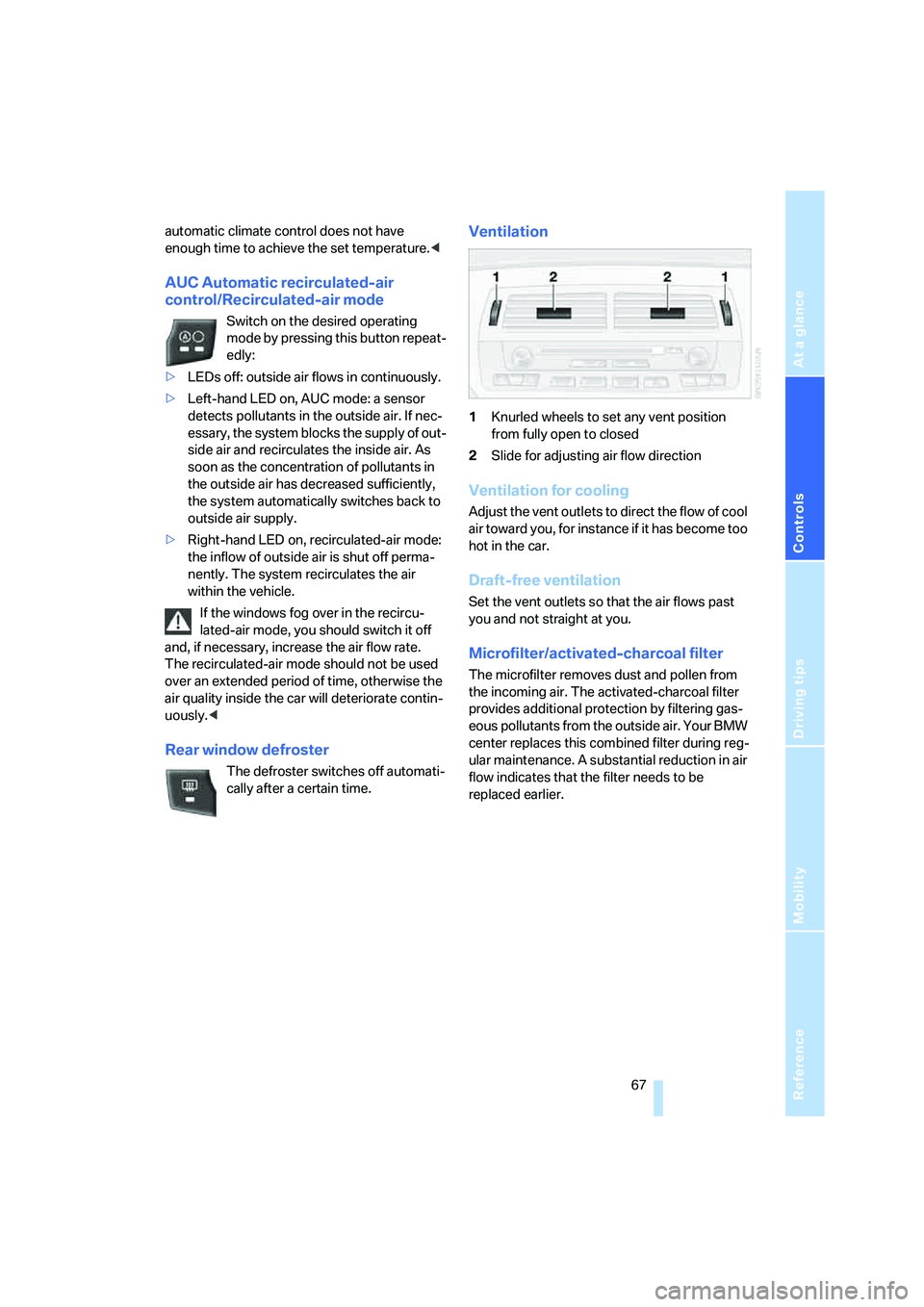
Reference
At a glance
Controls
Driving tips
Mobility
67
automatic climate control does not have
enough time to achieve the set temperature.<
AUC Automatic recirculated-air
control/Recirculated-air mode
Switch on the desired operating
mode by pressing this button repeat-
edly:
>LEDs off: outside air flows in continuously.
>Left-hand LED on, AUC mode: a sensor
detects pollutants in the outside air. If nec-
essary, the system blocks the supply of out-
side air and recirculates the inside air. As
soon as the concentration of pollutants in
the outside air has decreased sufficiently,
the system automatically switches back to
outside air supply.
>Right-hand LED on, recirculated-air mode:
the inflow of outside air is shut off perma-
nently. The system recirculates the air
within the vehicle.
If the windows fog over in the recircu-
lated-air mode, you should switch it off
and, if necessary, increase the air flow rate.
The recirculated-air mode should not be used
over an extended period of time, otherwise the
air quality inside the car will deteriorate contin-
uously.<
Rear window defroster
The defroster switches off automati-
cally after a certain time.
Ventilation
1Knurled wheels to set any vent position
from fully open to closed
2Slide for adjusting air flow direction
Ventilation for cooling
Adjust the vent outlets to direct the flow of cool
air toward you, for instance if it has become too
hot in the car.
Draft-free ventilation
Set the vent outlets so that the air flows past
you and not straight at you.
Microfilter/activated-charcoal filter
The microfilter removes dust and pollen from
the incoming air. The activated-charcoal filter
provides additional protection by filtering gas-
eous pollutants from the outside air. Your BMW
center replaces this combined filter during reg-
ular maintenance. A substantial reduction in air
flow indicates that the filter needs to be
replaced earlier.
Page 76 of 132

Things to remember when driving
74
Things to remember when driving
Break-in procedures
Moving parts need to be given some time until
they can interact smoothly with one another. To
ensure that your vehicle provides maximum
economy throughout a long service life, we
request that you observe the following.
Always obey all official speed limits.
Engine and differential
Up to 1,200 miles/2,000 km
Drive at varying engine and road speeds, but do
not exceed 4,500 rpm or 100 mph/160 km/h.
Refrain from using full throttle and avoid press-
ing the accelerator beyond the kickdown point.
After driving 1,200 miles/2,000 km
Engine and vehicle speeds can be gradually
increased.
Tires
Due to technical factors associated with their
manufacture, tires do not achieve their full trac-
tion potential until an initial break-in period has
elapsed. Therefore, drive cautiously during the
first 200 miles/300 km.
Brake system
Brakes require an initial break-in period of
approx. 300 miles/500 km to achieve optimized
contact and wear patterns between brake pads
and rotors. Drive cautiously during this break-in
period.
Clutch
The function of the clutch reaches its optimal
level only after a distance driven of approx.
300 miles/500 km. Shift gears carefully during
the break-in period.
After replacing components
The same break-in procedures should be
observed if any of the components mentioned
above have to be renewed in the course of the
vehicle's operating life.
Saving fuel
The fuel consumption of your vehicle depends
on several factors. You can lower fuel consump-
tion and the environmental impact by taking
certain measures, adjusting your driving style
and having the vehicle serviced regularly.
Remove any unneeded cargo
Additional weight increases fuel consumption.
Remove any mounted parts after you
have finished using them
Remove additional mirrors and the luggage rack
when they are no longer in use. Mounted parts
affect the vehicle's aerodynamics and increase
fuel consumption.
Close both windows
Open windows cause higher air resistance and
thus increase fuel consumption.
Check tire inflation pressure regularly
Check the tire inflation pressure at least twice a
month and before embarking on a long journey,
and correct it if necessary.
Low tire inflation pressure causes higher rolling
resistance and thus increases fuel consumption
and tire wear.
Set off immediately
Do not let the engine warm up while the car is
still standing, but set off immediately at moder-
ate engine speed. This is the fastest way for the
cold engine to reach its operating temperature.
Page 78 of 132
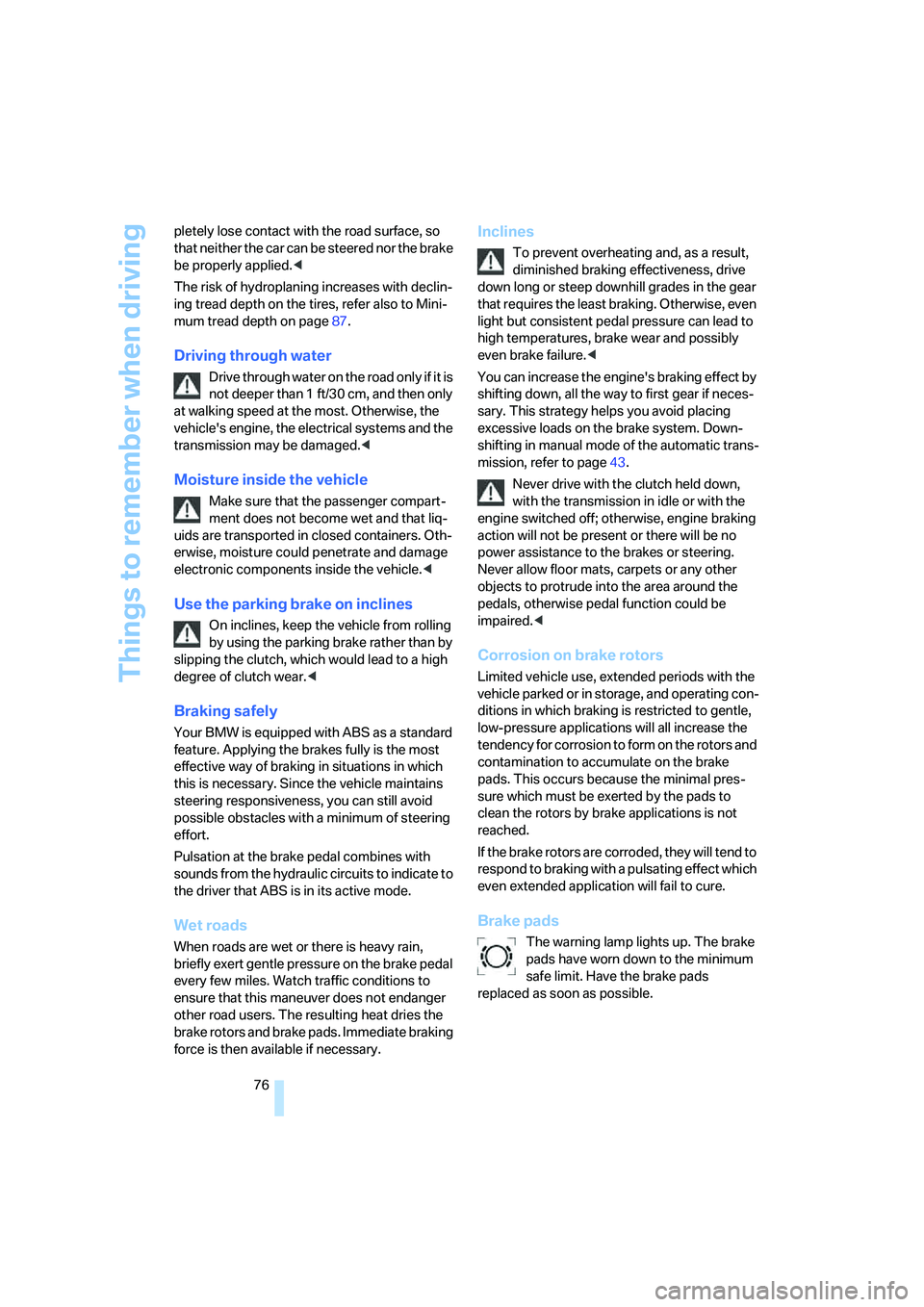
Things to remember when driving
76 pletely lose contact with the road surface, so
that neither the car can be steered nor the brake
be properly applied.<
The risk of hydroplaning increases with declin-
ing tread depth on the tires, refer also to Mini-
mum tread depth on page87.
Driving through water
Drive through water on the road only if it is
not deeper than 1 ft/30 cm, and then only
at walking speed at the most. Otherwise, the
vehicle's engine, the electrical systems and the
transmission may be damaged.<
Moisture inside the vehicle
Make sure that the passenger compart-
ment does not become wet and that liq-
uids are transported in closed containers. Oth-
erwise, moisture could penetrate and damage
electronic components inside the vehicle.<
Use the parking brake on inclines
On inclines, keep the vehicle from rolling
by using the parking brake rather than by
slipping the clutch, which would lead to a high
degree of clutch wear.<
Braking safely
Your BMW is equipped with ABS as a standard
feature. Applying the brakes fully is the most
effective way of braking in situations in which
this is necessary. Since the vehicle maintains
steering responsiveness, you can still avoid
possible obstacles with a minimum of steering
effort.
Pulsation at the brake pedal combines with
sounds from the hydraulic circuits to indicate to
the driver that ABS is in its active mode.
Wet roads
When roads are wet or there is heavy rain,
briefly exert gentle pressure on the brake pedal
every few miles. Watch traffic conditions to
ensure that this maneuver does not endanger
other road users. The resulting heat dries the
brake rotors and brake pads. Immediate braking
force is then available if necessary.
Inclines
To prevent overheating and, as a result,
diminished braking effectiveness, drive
down long or steep downhill grades in the gear
that requires the least braking. Otherwise, even
light but consistent pedal pressure can lead to
high temperatures, brake wear and possibly
even brake failure.<
You can increase the engine's braking effect by
shifting down, all the way to first gear if neces-
sary. This strategy helps you avoid placing
excessive loads on the brake system. Down-
shifting in manual mode of the automatic trans-
mission, refer to page43.
Never drive with the clutch held down,
with the transmission in idle or with the
engine switched off; otherwise, engine braking
action will not be present or there will be no
power assistance to the brakes or steering.
Never allow floor mats, carpets or any other
objects to protrude into the area around the
pedals, otherwise pedal function could be
impaired.<
Corrosion on brake rotors
Limited vehicle use, extended periods with the
vehicle parked or in storage, and operating con-
ditions in which braking is restricted to gentle,
low-pressure applications will all increase the
tendency for corrosion to form on the rotors and
contamination to accumulate on the brake
pads. This occurs because the minimal pres-
sure which must be exerted by the pads to
clean the rotors by brake applications is not
reached.
If the brake rotors are corroded, they will tend to
respond to braking with a pulsating effect which
even extended application will fail to cure.
Brake pads
The warning lamp lights up. The brake
pads have worn down to the minimum
safe limit. Have the brake pads
replaced as soon as possible.
Page 91 of 132
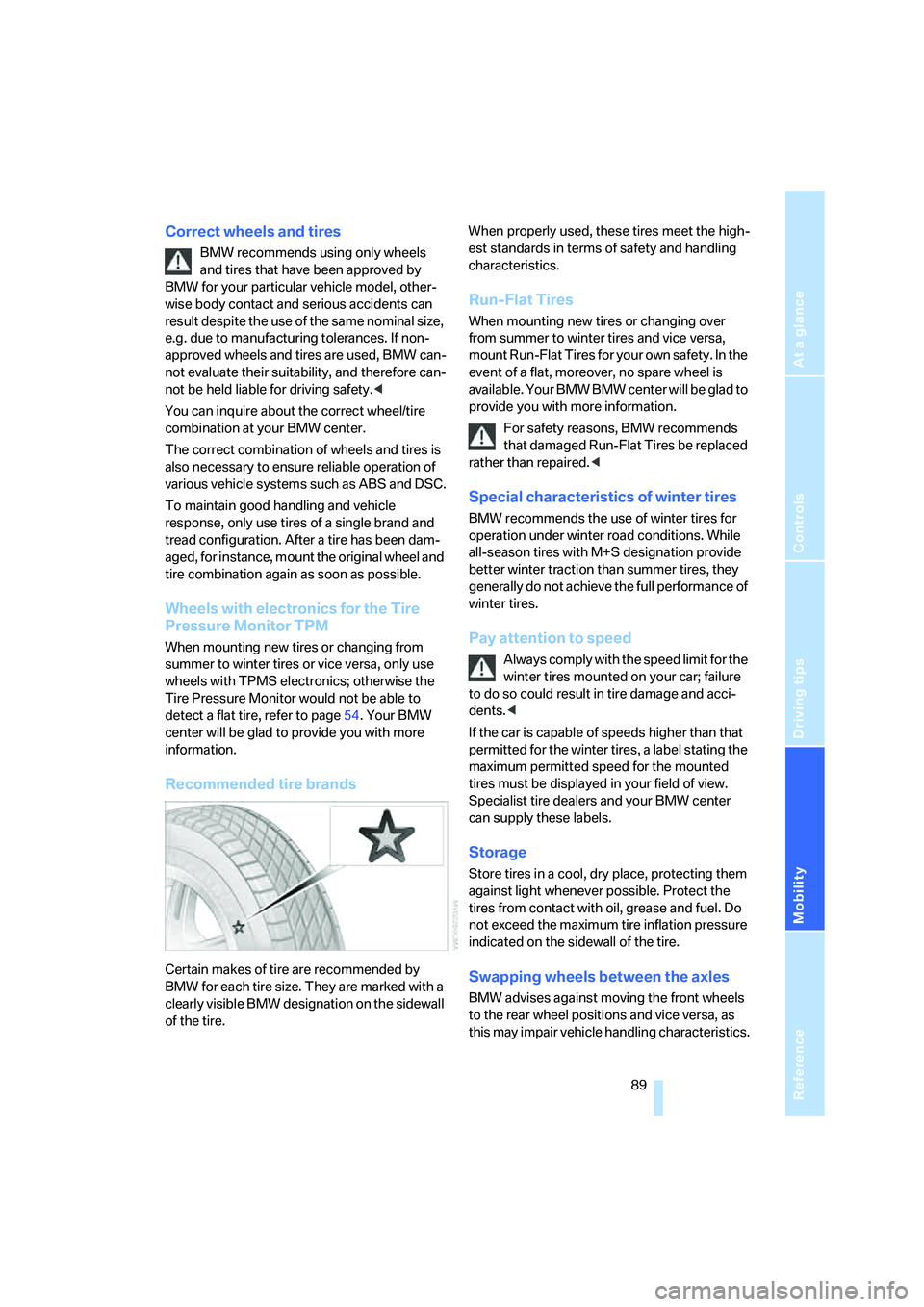
Reference
At a glance
Controls
Driving tips
Mobility
89
Correct wheels and tires
BMW recommends using only wheels
and tires that have been approved by
BMW for your particular vehicle model, other-
wise body contact and serious accidents can
result despite the use of the same nominal size,
e.g. due to manufacturing tolerances. If non-
approved wheels and tires are used, BMW can-
not evaluate their suitability, and therefore can-
not be held liable for driving safety.<
You can inquire about the correct wheel/tire
combination at your BMW center.
The correct combination of wheels and tires is
also necessary to ensure reliable operation of
various vehicle systems such as ABS and DSC.
To maintain good handling and vehicle
response, only use tires of a single brand and
tread configuration. After a tire has been dam-
aged, for instance, mount the original wheel and
tire combination again as soon as possible.
Wheels with electronics for the Tire
Pressure Monitor TPM
When mounting new tires or changing from
summer to winter tires or vice versa, only use
wheels with TPMS electronics; otherwise the
Tire Pressure Monitor would not be able to
detect a flat tire, refer to page54. Your BMW
center will be glad to provide you with more
information.
Recommended tire brands
Certain makes of tire are recommended by
BMW for each tire size. They are marked with a
clearly visible BMW designation on the sidewall
of the tire.When properly used, these tires meet the high-
est standards in terms of safety and handling
characteristics.
Run-Flat Tires
When mounting new tires or changing over
from summer to winter tires and vice versa,
mount Run-Flat Tires for your own safety. In the
event of a flat, moreover, no spare wheel is
available. Your BMW BMW center will be glad to
provide you with more information.
For safety reasons, BMW recommends
that damaged Run-Flat Tires be replaced
rather than repaired.<
Special characteristics of winter tires
BMW recommends the use of winter tires for
operation under winter road conditions. While
all-season tires with M+S designation provide
better winter traction than summer tires, they
generally do not achieve the full performance of
winter tires.
Pay attention to speed
Always comply with the speed limit for the
winter tires mounted on your car; failure
to do so could result in tire damage and acci-
dents.<
If the car is capable of speeds higher than that
permitted for the winter tires, a label stating the
maximum permitted speed for the mounted
tires must be displayed in your field of view.
Specialist tire dealers and your BMW center
can supply these labels.
Storage
Store tires in a cool, dry place, protecting them
against light whenever possible. Protect the
tires from contact with oil, grease and fuel. Do
not exceed the maximum tire inflation pressure
indicated on the sidewall of the tire.
Swapping wheels between the axles
BMW advises against moving the front wheels
to the rear wheel positions and vice versa, as
this may impair vehicle handling characteristics.
Page 98 of 132
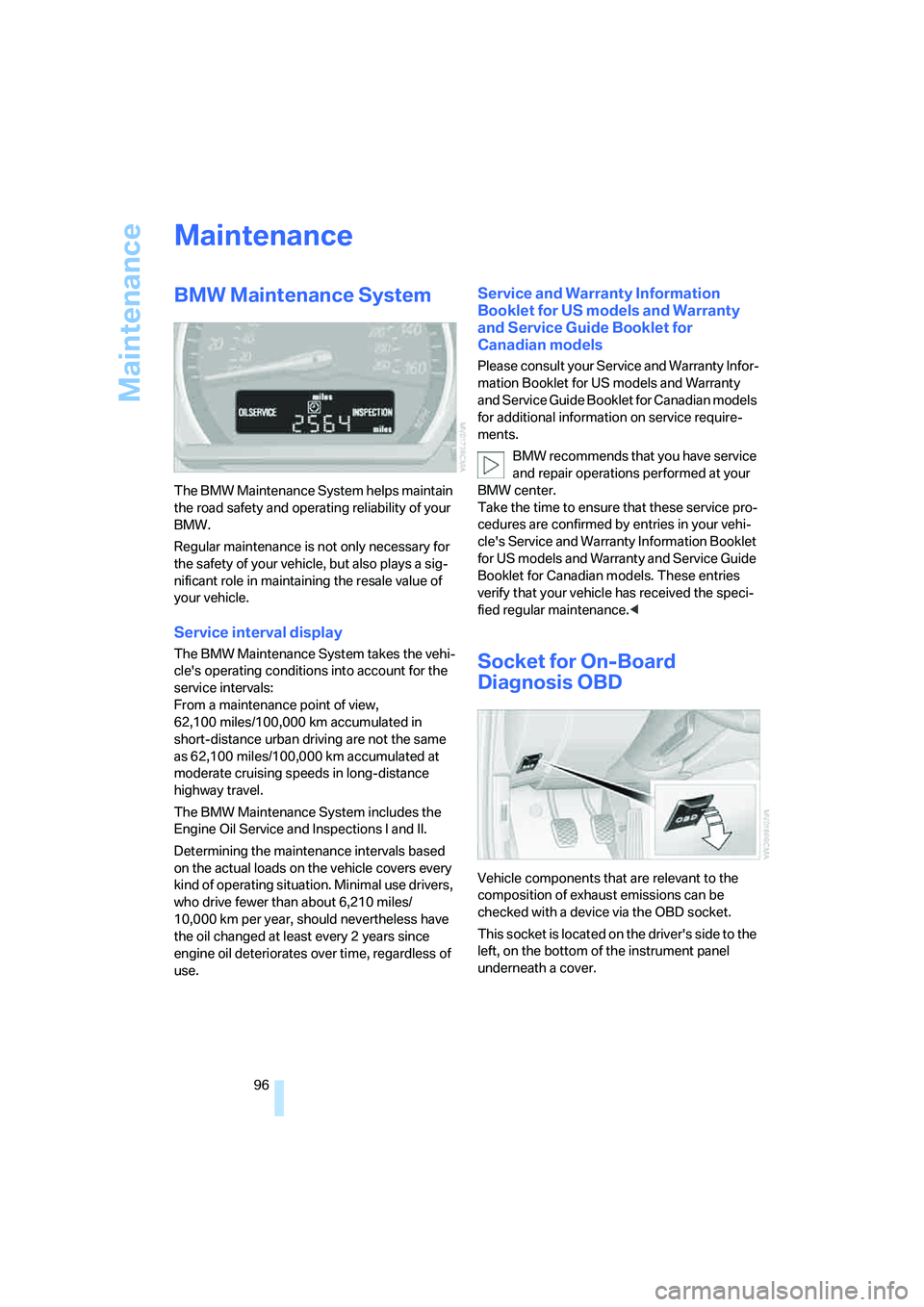
Maintenance
96
Maintenance
BMW Maintenance System
The BMW Maintenance System helps maintain
the road safety and operating reliability of your
BMW.
Regular maintenance is not only necessary for
the safety of your vehicle, but also plays a sig-
nificant role in maintaining the resale value of
your vehicle.
Service interval display
The BMW Maintenance System takes the vehi-
cle's operating conditions into account for the
service intervals:
From a maintenance point of view,
62,100 miles/100,000 km accumulated in
short-distance urban driving are not the same
as 62,100 miles/100,000 km accumulated at
moderate cruising speeds in long-distance
highway travel.
The BMW Maintenance System includes the
Engine Oil Service and Inspections I and II.
Determining the maintenance intervals based
on the actual loads on the vehicle covers every
kind of operating situation. Minimal use drivers,
who drive fewer than about 6,210 miles/
10,000 km per year, should nevertheless have
the oil changed at least every 2 years since
engine oil deteriorates over time, regardless of
use.
Service and Warranty Information
Booklet for US models and Warranty
and Service Guide Booklet for
Canadian models
Please consult your Service and Warranty Infor-
mation Booklet for US models and Warranty
and Service Guide Booklet for Canadian models
for additional information on service require-
ments.
BMW recommends that you have service
and repair operations performed at your
BMW center.
Take the time to ensure that these service pro-
cedures are confirmed by entries in your vehi-
cle's Service and Warranty Information Booklet
for US models and Warranty and Service Guide
Booklet for Canadian models. These entries
verify that your vehicle has received the speci-
fied regular maintenance.<
Socket for On-Board
Diagnosis OBD
Vehicle components that are relevant to the
composition of exhaust emissions can be
checked with a device via the OBD socket.
This socket is located on the driver's side to the
left, on the bottom of the instrument panel
underneath a cover.
Page 99 of 132
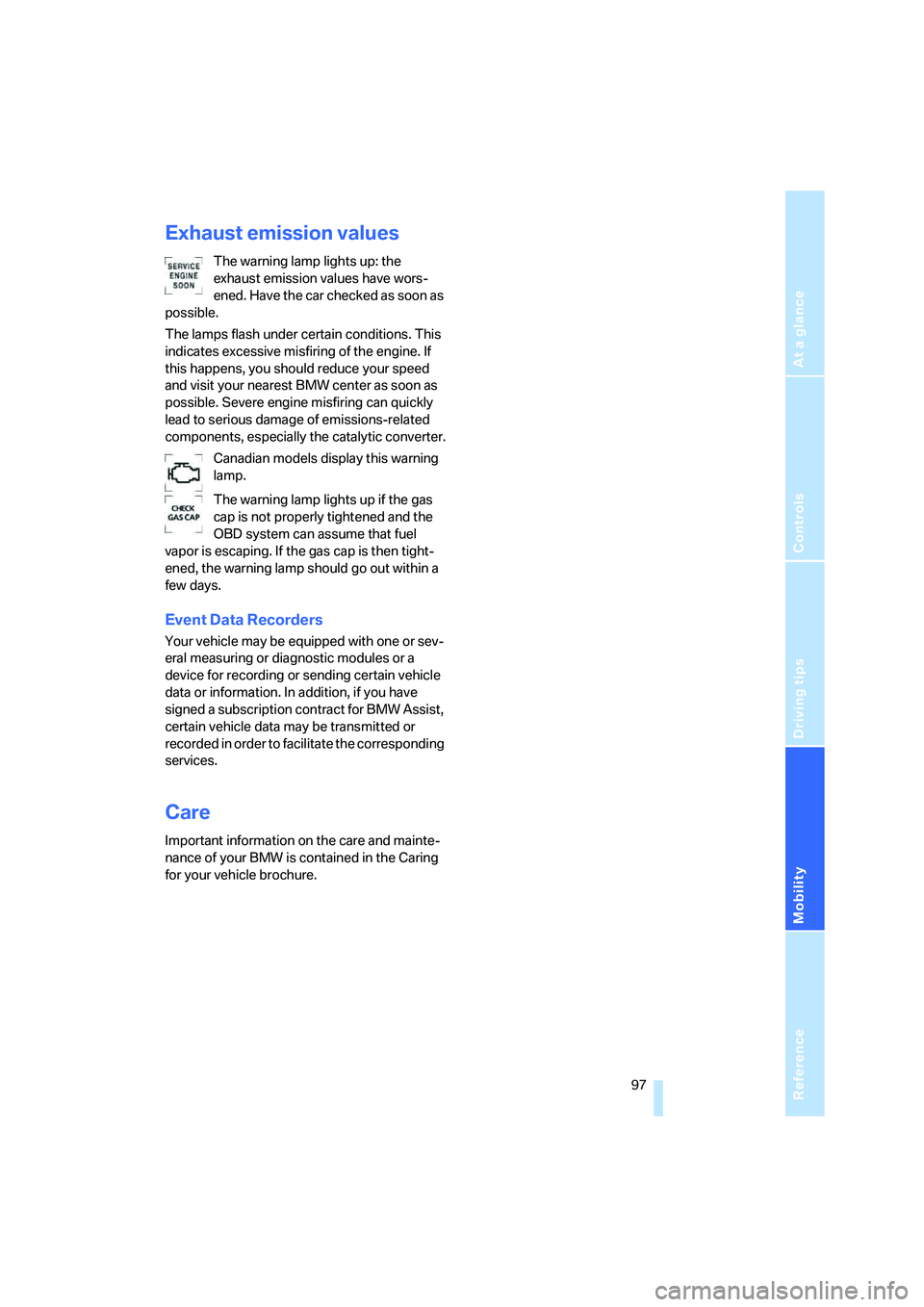
Reference
At a glance
Controls
Driving tips
Mobility
97
Exhaust emission values
The warning lamp lights up: the
exhaust emission values have wors-
ened. Have the car checked as soon as
possible.
The lamps flash under certain conditions. This
indicates excessive misfiring of the engine. If
this happens, you should reduce your speed
and visit your nearest BMW center as soon as
possible. Severe engine misfiring can quickly
lead to serious damage of emissions-related
components, especially the catalytic converter.
Canadian models display this warning
lamp.
The warning lamp lights up if the gas
cap is not properly tightened and the
OBD system can assume that fuel
vapor is escaping. If the gas cap is then tight-
ened, the warning lamp should go out within a
few days.
Event Data Recorders
Your vehicle may be equipped with one or sev-
eral measuring or diagnostic modules or a
device for recording or sending certain vehicle
data or information. In addition, if you have
signed a subscription contract for BMW Assist,
certain vehicle data may be transmitted or
recorded in order to facilitate the corresponding
services.
Care
Important information on the care and mainte-
nance of your BMW is contained in the Caring
for your vehicle brochure.
Page 122 of 132
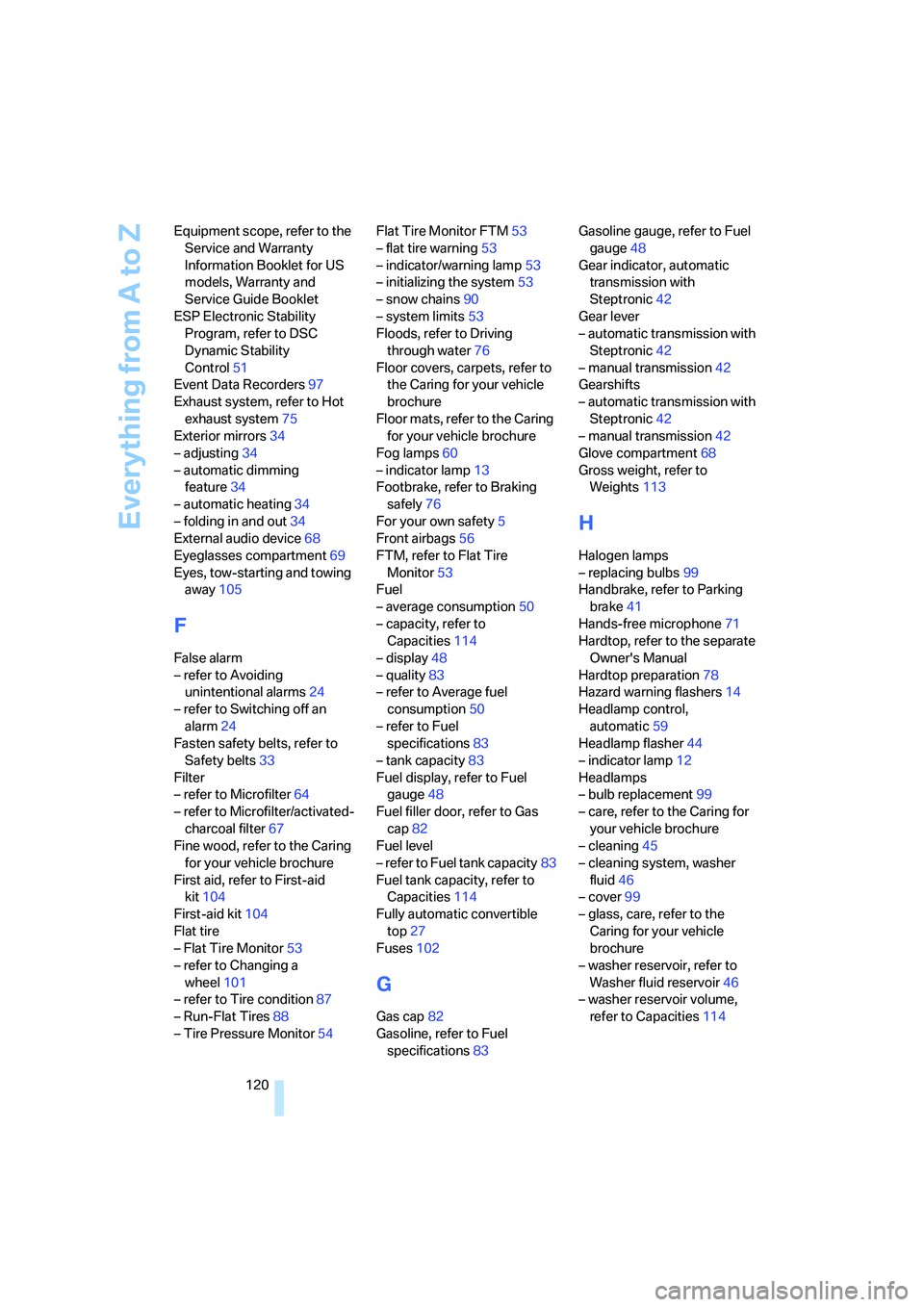
Everything from A to Z
120 Equipment scope, refer to the
Service and Warranty
Information Booklet for US
models, Warranty and
Service Guide Booklet
ESP Electronic Stability
Program, refer to DSC
Dynamic Stability
Control51
Event Data Recorders97
Exhaust system, refer to Hot
exhaust system75
Exterior mirrors34
– adjusting34
– automatic dimming
feature34
– automatic heating34
– folding in and out34
External audio device68
Eyeglasses compartment69
Eyes, tow-starting and towing
away105
F
False alarm
– refer to Avoiding
unintentional alarms24
– refer to Switching off an
alarm24
Fasten safety belts, refer to
Safety belts33
Filter
– refer to Microfilter64
– refer to Microfilter/activated-
charcoal filter67
Fine wood, refer to the Caring
for your vehicle brochure
First aid, refer to First-aid
kit104
First-aid kit104
Flat tire
– Flat Tire Monitor53
– refer to Changing a
wheel101
– refer to Tire condition87
– Run-Flat Tires88
– Tire Pressure Monitor54Flat Tire Monitor FTM53
– flat tire warning53
– indicator/warning lamp53
– initializing the system53
– snow chains90
– system limits53
Floods, refer to Driving
through water76
Floor covers, carpets, refer to
the Caring for your vehicle
brochure
Floor mats, refer to the Caring
for your vehicle brochure
Fog lamps60
– indicator lamp13
Footbrake, refer to Braking
safely76
For your own safety5
Front airbags56
FTM, refer to Flat Tire
Monitor53
Fuel
– average consumption50
– capacity, refer to
Capacities114
– display48
– quality83
– refer to Average fuel
consumption50
– refer to Fuel
specifications83
– tank capacity83
Fuel display, refer to Fuel
gauge48
Fuel filler door, refer to Gas
cap82
Fuel level
– refer to Fuel tank capacity83
Fuel tank capacity, refer to
Capacities114
Fully automatic convertible
top
27
Fuses102
G
Gas cap82
Gasoline, refer to Fuel
specifications83Gasoline gauge, refer to Fuel
gauge48
Gear indicator, automatic
transmission with
Steptronic42
Gear lever
– automatic transmission with
Steptronic42
– manual transmission42
Gearshifts
– automatic transmission with
Steptronic42
– manual transmission42
Glove compartment68
Gross weight, refer to
Weights113
H
Halogen lamps
– replacing bulbs99
Handbrake, refer to Parking
brake41
Hands-free microphone71
Hardtop, refer to the separate
Owner's Manual
Hardtop preparation78
Hazard warning flashers14
Headlamp control,
automatic59
Headlamp flasher44
– indicator lamp12
Headlamps
– bulb replacement99
– care, refer to the Caring for
your vehicle brochure
– cleaning45
– cleaning system, washer
fluid46
– cover99
– glass, care, refer to the
Caring for your vehicle
brochure
– washer reservoir, refer to
Washer fluid reservoir46
– washer reservoir volume,
refer to Capacities114
Page 128 of 132

Everything from A to Z
126 Tow-starting106
Tow truck106
TPM Tire Pressure
Monitor54
Track width, refer to
Dimensions111,112
Traction control, refer to
Dynamic Stability Control
DSC51
Transmission
– automatic transmission with
Steptronic42
– manual transmission42
Transmission detent, refer to
Range selection42
Transmission malfunction,
refer to Malfunction43
Transporting children
safely36
Transport securing device,
refer to Cargo loading77
Tread depth, refer to Minimum
tread depth87
Trip distance recorder, refer to
Trip odometer48
Triple turn signal44
Trip meter, refer to Trip
odometer48
Trip odometer48
Turning circle, refer to
Dimensions111,112
Turn signal indicators44
– bulb replacement100
– indicator lamp12,13
Turn signals
– triple turn signal44
TV function, refer to Owner's
Manual for Onboard
Computer
Tying down loads, refer to
Cargo loading77
U
Undercoating, refer to the
Caring for your vehicle
brochure
Uniform Tire Quality Grading/
UTQR86Units
– average consumption50
– average speed50
– temperature50
– time50
Units of measure
– outside temperature
display50
– time format50
Unlatching, refer to
Unlocking19
Unlocking
– from inside21
– from outside19
– luggage compartment
lid20,22
– tailgate20,21
Used batteries, refer to
Battery disposal102
V
Vehicle
– battery102
– break-in period74
– care, refer to the Caring for
your vehicle brochure
– cargo loading77
– car wash, refer to the Caring
for your vehicle brochure
– dimensions, refer to
Dimensions111,112
– engine41
– leaving the vehicle41
– parked77
– placing in storage, refer to
the Caring for your vehicle
brochure
– weight113
Vehicle Memory18
Ventilation63,67
– air conditioning63
– automatic climate control67
– draft-free63,67
Vents, refer to
Ventilation63,67
Viscosity94Volume
– fuel tank, refer to
Capacities114
W
Warning and indicator
lamps12
Warning triangle104
Warranty, refer to Service and
Warranty Information
Booklet for US models,
Warranty and Service Guide
Booklet for Canadian
models96
Warranty and service6
Washer/wiper system45
Washer fluid reservoir46
Washer fluids46
Washer reservoir, refer to
Washer fluid reservoir46
Washing systems46
Waste tray, refer to Ashtray69
Water on roads, refer to
Driving through water76
Wear indicator in tires, refer to
Minimum tread depth87
Weights113
Wheel/tire combination, refer
to Correct wheels and
tires89
Wheelbase, refer to
Dimensions111,112
Wheels and tires84
Width, refer to
Dimensions111,112
Wind deflector70
Window defrosting, refer to
Defrosting windows
– automatic climate control66
– heating and ventilation63
Windows24
– convenience operation20
– opening/closing25
– pinch protection system25
– power supply interruption25